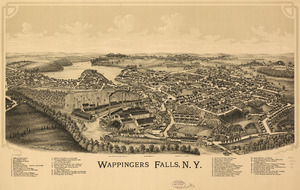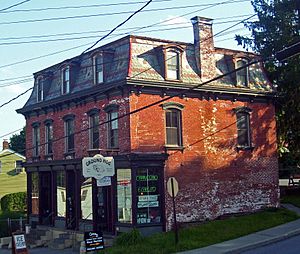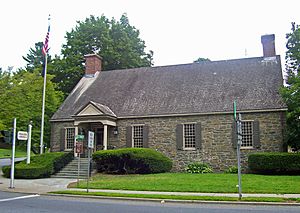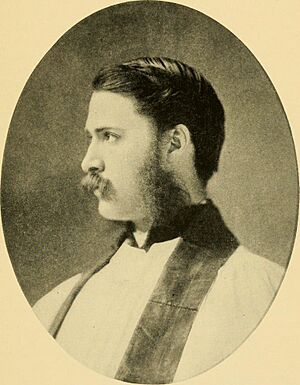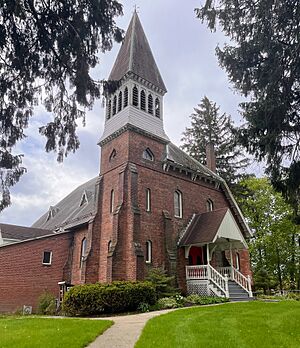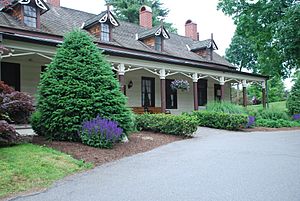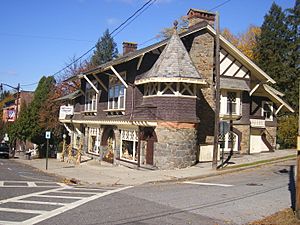Wappingers Falls, New York facts for kids
Quick facts for kids
Wappingers Falls, New York
|
||
|---|---|---|

Downtown Wappingers Falls
|
||
|
||
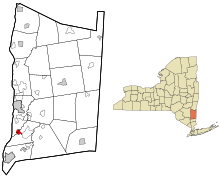
Location of Wappingers Falls, New York
|
||
| Country | United States | |
| State | New York | |
| County | Dutchess | |
| Towns | Wappinger, Poughkeepsie | |
| Incorporated | 1871 | |
| Area | ||
| • Total | 1.20 sq mi (3.11 km2) | |
| • Land | 1.12 sq mi (2.90 km2) | |
| • Water | 0.08 sq mi (0.20 km2) | |
| Elevation | 154 ft (47 m) | |
| Population
(2020)
|
||
| • Total | 6,103 | |
| • Density | 5,444.25/sq mi (2,102.14/km2) | |
| Time zone | UTC−5 (Eastern (EST)) | |
| • Summer (DST) | UTC−4 (EDT) | |
| ZIP Code |
12590
|
|
| Area code(s) | 845 | |
| FIPS code | 36-78168 | |
| GNIS feature ID | 0968775 | |
Wappingers Falls is a village located in Dutchess County, New York, United States. It is part of the towns of Poughkeepsie and Wappinger. In 2010, about 5,522 people lived here. The village gets its name from the beautiful waterfall in Wappinger Creek.
The Wappingers Falls post office serves a larger area than just the village. This can sometimes be confusing for people who live nearby but not actually inside the village. The Grinnell Library, found in the village, is the sixth-oldest library in New York State.
Contents
Exploring the History of Wappingers Falls
The area around Wappingers Falls was once home to the Wappinger people. They were a group of Native Americans who spoke an Algonquian language. Their land in the 1600s stretched along the eastern side of the Hudson River. The name Wappinger means "easterner" in many Algonquian languages.
Early Settlements and Mills
In 1741, two Dutchmen, Nicholas and Adolphus Brewer, bought about 750 acres of land near the waterfall. They built the first stone house in the village. In 1742, the Brewers also built a mill on the east side of Wappinger Creek. Nicholas Brewer later built the Mesier Homestead. He sold it in 1777 to Matthew VanBenschoten, who then sold it to Peter Mesier Sr.
In May 1777, during the American Revolution, some soldiers and local people went to Peter Mesier's house. They were upset about the high price of tea he was selling. Mesier was a merchant from New York City and supported the British. The group took the tea and left some money behind.
The waterfall was very important for early factories. In 1819, a small cotton mill was built in the area where the creek flows down to the Hudson River. By 1856, it had grown into one of the biggest printing factories in the country. A fire destroyed the buildings that year, but they were quickly rebuilt. The factory continued to operate until 1931. Many of the houses on the hillside were built by the mill for its workers. An 1884 stone arch bridge connects the two parts of the village. It replaced older wooden bridges.
Village Growth and Changes
The village of Wappingers Falls officially became a village in 1871. It included the nearby community on the west side of Wappinger Creek, which was called Channingville. The east side was known as Franklindale. In 1885, the Franklindale Cotton Mill, which had about 130 workers, was destroyed by fire.
Later, in 1909, the Garner Print Works factory was sold. It became the Dutchess Bleachery. This plant sometimes employed as many as 1,150 people. It stopped printing fabric but continued to bleach and dye materials.
On June 3, 2017, a large fire happened in downtown Wappingers Falls. It caused damage to several buildings and forced over 30 people to leave their homes. Six businesses also had to close temporarily. Luckily, no one was hurt in the fire.
Channingville: A Part of the Village
The part of the village north of the creek, in the town of Poughkeepsie, was first called "Ednam." It later became known as Channingville. This name came from the Channing family, who owned the land there.
The first merchant in this area was John Crilley, who made barrels. In 1842, he built the first brick building on either side of the creek. By 1836, Ednam had about thirty homes and a cotton factory. This factory made 500,000 yards of cloth each year.
The Bain Commercial Building is located at the corner of Church and West Main streets. The Bain family likely built it in 1875. It was both their home and their business. This brick building was added to the National Register of Historic Places in 1984.
Discovering Historic Places
The Wappingers Falls Historic District includes the downtown area, several neighborhoods, and Mesier Park & Homestead. Mesier Park has been a public park since around 1891. It hosts many yearly events around its bandstand and tree-lined paths. In 1984, this district was added to the National Register of Historic Places.
The Dutchess Company Superintendent's House is on Market Street. This large brick house was built for the manager of the Dutchess Company, a big local printing factory. It was built shortly after the factory in 1848. The house stayed with the company until it closed. In 1984, it was also added to the National Register of Historic Places.
The Police Station is at the corner of South Avenue and East Main Street. It was built in 1940 as the village's new post office. President Franklin D. Roosevelt was very interested in this project. He wanted it to be built from fieldstone, like many old Dutch houses in the area. He chose the Brewer-Mesier House in the village as the design model. The old post office building has two murals by Henry Billings. These paintings show two different views of the town's waterfall, one from 1780 and another from 1880.
Places of Worship
Wappingers Falls has several historic churches that have served the community for many years.
Zion Episcopal Church
Zion Episcopal Church started in 1820 with a Sunday school class led by Joanna Mesier. There were only a few families living in the area back then. The class later moved to a barn. In 1833, Reverend Doctor George B. Andrews began holding official church services. Matthew Mesier donated land for a church building in December 1833. Stone for the church came from Benjamin Clapp's property. Zion Protestant Episcopal Church was dedicated on May 6, 1836. One famous pastor was Henry Yates Satterlee, who later became the first bishop of Washington. He helped establish the Washington National Cathedral.
Bethel Missionary Baptist Church
The Franklindale Baptist Church was formed in 1838. Benjamin Clapp, who used to be a warden at Zion Episcopal, became a Baptist. He donated land for the church building. The church was dedicated on December 5, 1847. In 1967, the Bethel Baptist community bought the Franklindale Baptist church. It was renamed Bethel Missionary Baptist Church. In 1997, they bought another building for their church school and events. Later, a new church building was constructed.
First Presbyterian Church
The Presbyterian Church in Wappingers Falls began because of Mrs. John Fisher Sheafe. She asked a reverend to see if a church was needed in Wappingers. This led to the creation of the Presbyterian Society in 1848. That same year, a church and a house for the pastor were built on Fulton Street. Later, the church moved to a new brick building on South Avenue. This new church was dedicated on July 23, 1872. The church served the community for over 150 years before closing in 2023.
United Methodist Church of Wappingers Falls
The first Methodist Episcopal Church in the Wappingers Falls area started in 1788. By 1824, services were held in people's homes and then in a schoolhouse. In 1827, the Methodist Society bought a former Baptist meeting house. In 1841, it became part of a larger church circuit. Land was donated for a new church building in 1845. In 1868, the Wappingers Falls and Middlebush congregations decided to merge. The old Middlebush church was taken down, and its materials were used to build a barn at the new church property on Mesier Avenue.
The church's name changed over the years. In 1939, it became The Methodist Church. In 1968, it changed to the United Methodist Church. In 1974, it merged with the New Hamburg Methodist Church. In early 2020, the church merged with the Poughkeepsie United Methodist Church, and the building was sold.
St. Mary's Church
Roman Catholics in Wappingers Falls were served by priests from Poughkeepsie until 1845. That year, a new church parish was started for southern Dutchess County. In 1850, the first pastor moved to the area. Church services were held in homes until a church was built on Clinton Street. The current church building was dedicated in 1879. Its inside has been updated several times, most recently in the early 2000s. The parish also has a cemetery and a school, which closed in 2019.
Mount Alvernia and the Monastery of St. Clare
Mount Alvernia Retreat Center is a large property with beautiful views of the Hudson Valley. It is run by the Franciscan Friars. It was built in 1950 and was used to train Franciscan friars until 1967. Its chapel holds daily Mass, and the building hosts retreats and other events.
On the same property is the Monastery of St. Clare. It was built in 2004 for the Poor Clares, who are Franciscan nuns. They moved to Wappingers Falls from the Bronx.
Geography and Location
Wappingers Falls is located where Wappinger Creek becomes deep enough for boats. This is about 2 miles northeast of where the creek meets the Hudson River. The village covers about 3.1 square kilometers (1.2 square miles). Most of this area is land, with a small part being water.
The Wappinger Creek flows right through the village. The Wappingers Falls post office serves the village and parts of several nearby towns. US 9 and NY 9D are major roads that pass through the village.
Population and People
| Historical population | |||
|---|---|---|---|
| Census | Pop. | %± | |
| 1870 | 2,263 | — | |
| 1890 | 3,718 | — | |
| 1900 | 3,504 | −5.8% | |
| 1910 | 3,195 | −8.8% | |
| 1920 | 3,235 | 1.3% | |
| 1930 | 3,336 | 3.1% | |
| 1940 | 3,427 | 2.7% | |
| 1950 | 3,490 | 1.8% | |
| 1960 | 4,447 | 27.4% | |
| 1970 | 5,607 | 26.1% | |
| 1980 | 5,110 | −8.9% | |
| 1990 | 4,605 | −9.9% | |
| 2000 | 4,929 | 7.0% | |
| 2010 | 5,522 | 12.0% | |
| 2020 | 6,103 | 10.5% | |
| U.S. Decennial Census | |||
According to the 2010 census, Wappingers Falls had a population of 5,522 people. Most residents were white (72.5%). Other groups included African American (7.4%), Asian (4.8%), and people of two or more races (4.9%). About 26.2% of the population identified as Hispanic or Latino. The average age of residents was 35.5 years old.
The average household income in the village was $39,123. For families, the average income was $50,000. About 12.3% of the population lived below the poverty line.
Entertainment and Arts
The County Players Falls Theatre is located on West Main Street. It is a volunteer-run community theater. It is in the old Academy Theatre building.
Residents can watch many TV stations. These include channels from New York City and Albany. Cablevision also provides these stations.
Education in Wappingers Falls
St. Mary Elementary School was a Catholic school that served students from kindergarten to 8th grade. It opened in 1893 and closed in 2019. It had 118 students when it closed.
The Village of Wappingers Falls is part of the Wappingers Central School District. Currently, there are no schools directly inside the village. However, James S. Evans Elementary School and Wappingers Junior High School are very close to the village borders.
Transportation Options
The New Hamburg station is on Metro-North Railroad's Hudson Line. This train station serves Wappingers Falls residents. Stewart International Airport is also nearby, located across the Newburgh–Beacon Bridge. It offers both domestic and international flights.
Notable People from Wappingers Falls
- Dan Brouthers: A famous baseball player who was inducted into the Baseball Hall of Fame in 1945. He lived in the village and is buried in St. Mary's Cemetery.
- Jack Mulhall: A silent film actor who was born in Wappingers Falls.
- John Regan: A highly praised bass guitar player.
- Frederick W. Rowe: A former U.S. Representative.
- Wallace Worsley: An actor.
- Tyler Adams: A professional soccer player for AFC Bournemouth and the U.S. Men's National Team.
- Jeh Johnson: The 4th United States Secretary of Homeland Security.
Books Featuring Wappingers Falls
- Ward Moore's 1953 alternate history novel Bring the Jubilee is partly set in Wappingers Falls.
See also
 In Spanish: Wappingers Falls para niños
In Spanish: Wappingers Falls para niños



